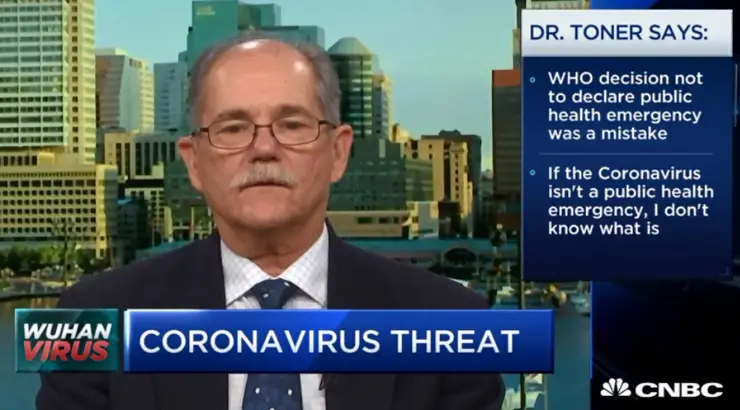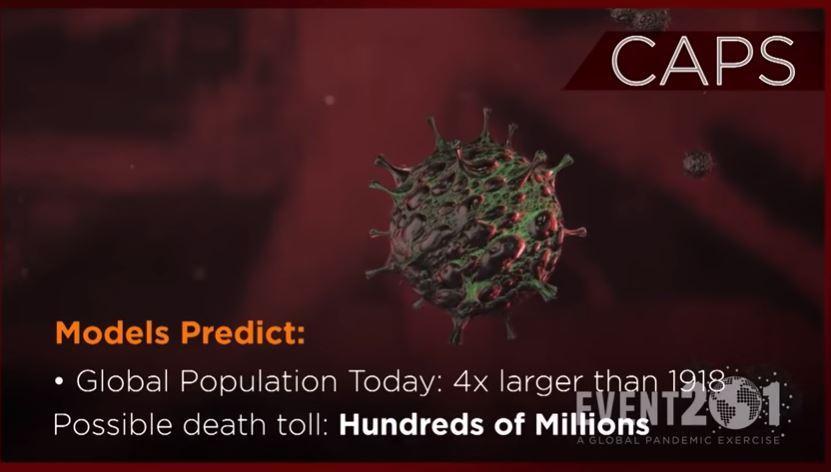News
Scientist Who Simulated Global Coronavirus Outbreak 3 Months Ago Makes Chilling Statement
The simulation showed how a global coronavirus (not 2019-nCoV) outbreak could potentially kill hundreds of millions of people.

(TMU) — A senior scientist who participated in a simulation of the global impact of a coronavirus outbreak has stated that “the cat is out of the bag” when it comes to the virus and that China is unlikely to contain its spread.
Eric Toner, Senior Scholar with the Johns Hopkins Center for Health Security and Senior Scientist in the Johns Hopkins Bloomberg School of Public Health, Department of Environmental Health and Engineering, said during an interview with CNBC that China’s efforts to contain the current outbreak of the rapidly spreading upper-respiratory illness known as 2019-nCoV are “unlikely to be effective.”
Three months ago Toner, along with the World Economic Forum and the Bill & Melinda Gates Foundation, took part in a simulation called Event 201 centered around a fictional coronavirus (not 2019-nCoV) named CAPS that could potentially kill hundreds of millions of people under the right circumstances.

Screenshot from the ‘Event 201’ simulation.
Johns Hopkins Center for Health Security recently issued a statement about Event 201:
“Recently, the Center for Health Security has received questions about whether that pandemic exercise predicted the current novel coronavirus outbreak in China. To be clear, the Center for Health Security and partners did not make a prediction during our tabletop exercise. For the scenario, we modeled a fictional coronavirus pandemic, but we explicitly stated that it was not a prediction.”
The World Health Organization (WHO) has declined to call the situation a global emergency at this time. However, the Geneva-based organization stated that it considers China’s current situation a health emergency. As of Sunday night WHO director-general Tedros Adhanom Ghebreyesus was on his way to Beijing to “strengthen our partnership” with China “in providing further protection against the outbreak,” according to Reuters.
Toner stated during the CNBC interview that he believed it was a mistake for the World Health Organization to not issue a global public health emergency. He went on to describe the threat from his point of view, expressing that the point of their exercise wasn’t just to estimate death toll but to showcase the potential consequences on society and the global economy.
Toner asserted China has participated in the “largest effort ever to contain a city.“ However, the doctor also said, “I don’t think it’s likely to be effective, as people have already escaped.” Wuhan’s mayor Zhou Xianwang revealed on Sunday that he was correct. During a press conference, the mayor stated that an estimated 5 million residents had already left the city due to the virus outbreak and Chinese New Year celebrations.
China has so far quarantined at least 50 million people as TMU reported over the weekend. The country has also locked-down much of its transportation system within cities barring citizens from traveling in an attempt to control the virus spread.
According to reports on Twitter, U.S. residents are being evacuated on a flight today from Wuhan.
Lots of things going on right now. People are getting calls confirming their spot on the plane! Unfortunately there is zero solution provided for transportation. All public transport is closed, and people won’t venture out to give you a lift. #wuhan #coronavirus
— ℂ??????? ??? ℂ???? (@plantsNbabes) January 27, 2020
China’s latest announcement puts the totals at 82 dead from the virus and nearly 3,000 people infected. However, according to Prof. Neil Ferguson, a public health expert at Imperial College, the true number is likely closer to 100,000 affected by the virus. On Monday University of Hong Kong academics estimated that 43,590 people were infected in Wuhan as of Saturday, according to the South China Morning Post.
According to the Daily Mail, a report written by researchers from England, Scotland, and Florida believe that up to 350,000 people could potentially be infected in Wuhan by the beginning of February.
On Sunday, the minister in charge of China’s National Health Commission (NHC), Ma Xiaowei, admitted that battling the outbreak had become difficult after it was discovered that the new virus could be transmitted even during the incubation period, which separates the virus from SARS (Severe Acute Respiratory Syndrome) which lacked that trait.
The virus’ incubation period allowing infection may be what makes the virus more dangerous than most in its family. Ma explained, “From observations, the virus is capable of transmission even during incubation period.” He indicated that the incubation period lasted from one to 14 days. “Some patients have normal temperatures and there are many milder cases. There are hidden carriers.”
Ma added that upwards to 2,360 military and civilian doctors and nurses had been sent to Wuhan from Beijing to combat the virus.
In the United States, the Centers for Disease Control and Prevention (CDC) announced over the weekend that there are now five confirmed cases in the U.S with a new case in Arizona. The CDC issued mixed messages on Sunday, first stating coronavirus is an “emerging public threat” that is “serious” and later contradicting itself by saying it was a “low” threat to the U.S. population at this time.
CDC says coronavirus is not spreading in the U.S. at this time, which means the threat to the U.S. population is "low at this time" https://t.co/hSjr1uHLLa
— BNO Newsroom (@BNODesk) January 26, 2020
Thus far deaths have only been reported in China, but that could change quickly as the Chinese government admitted on Sunday that the virus is “strengthening.” Scientists have estimated the virus has a reproduction (R0) rate of between 2.5 and 3.8 according to Dr. Eric Feigl-Ding a public health scientist who taught 15 years at Harvard and an NYT-featured pharma whistleblower.
https://twitter.com/DrEricDing/status/1220919589623803905?s=19
UPDATE: Transmission of #coronoavirus estimated at 2.6 by another research group (lower than the 3.8 initial reports). But 2.6 is still extremely bad —each infected person will infect 2.6 others. Even the authors admit #CoronaOutbreak containment will be very difficult. Thread: pic.twitter.com/Gg2vyIevL4
— Eric Feigl-Ding (@DrEricDing) January 25, 2020
Symptoms include fever, cough, shortness of breath, and breathing difficulties. However, according to Chinese state media some are not experiencing any of these symptoms and are instead experiencing nausea, diarrhea, tiredness, bad concentration, headache, irregular heartbeat, chest pain, cornea inflammation, and muscular pains in the limbs, back, and waist.
U.S President Donald Trump tweeted Monday morning that the U.S. is “in very close communication with China concerning the virus.”
We are in very close communication with China concerning the virus. Very few cases reported in USA, but strongly on watch. We have offered China and President Xi any help that is necessary. Our experts are extraordinary!
— Donald J. Trump (@realDonaldTrump) January 27, 2020
UPDATE 5:15pm EST — On Monday, the WHO “admitted an error” in assessing the risk of the coronavirus. A Sunday night situation report listed the risk as “very high in China, high at the regional level and high at the global level,” according to the AFP. The WHO admits that the agency “incorrectly” listed the global risk as moderate in reports on Thursday, Friday, and Saturday.
By Aaron Kesel | Creative Commons | TheMindUnleashed.com
Typos, corrections and/or news tips? Email us at Contact@TheMindUnleashed.com
